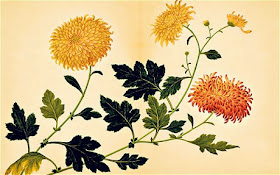Writing of his experiences in World War I, Edmund Blunden in
‘Vlamertinghe: Passing the Chateau’:
“…Bold great daisies' golden lights,
Bubbling roses' pinks and whites—
Such a gay carpet! poppies by the million;
Such damask! such vermilion!
But if you ask me, mate, the choice of colour
Is scarcely right; this red should have been duller.”
On September 18 2007, I wrote on "self-absorption" of writers. Read it
here.
As mentioned there, apparently, writers from
Kalidasa to
Dnyaneshwar (ज्ञानेश्वर) and beyond never mention a butterfly/ moth in their writings!
I claim this based on a book 'Nisrgotsav' by the late
Durga Bhagwat. (“
पिवळीच मी पाकोळी की”/
निसर्गोत्सव, 1996 लेखक: दुर्गा भागवत)
Now, I have learnt a little more on the subject.
In the issue dated
September 25 2014 of the The New York Review of Books,
Robin Lane Fox says:
"...Surprisingly, the poetry of flowers is often patchy and ill-informed.
None of the ancient
Greek poets mentions the brilliant wild tulips that
run like red rivers through parts of the Greek landscape.
Chinese poets
focus on a narrow canon of flowers, soaked in symbolism and hidden
meanings. They say nothing about the heavenly wild flora, the superb
shrubs and mountain flowers that have transformed
Western gardens since
their collection and introduction by
Europeans.
John Milton’s poetry
describes bunches of flowers that would never flower during one and the
same season. No gardener, especially in
Britain this year, would agree
that April is “the cruellest month” and in no gardens or landscapes
known to me does April breed “lilacs out of the dead land,” least of all
on the
American East Coast within range of the young
T.S. Eliot..."
Very big names, very big civilizations were mentioned there...
Chinese poets
focus on a narrow canon of flowers, soaked in symbolism and hidden
meanings. They say nothing about the heavenly wild flora, the superb
shrubs and mountain flower...
And so is true of
Indians.
For Indian writers, lotus and rose- followed by
Parijat (Night-flowering Jasmine),
Champak (Magnolia champaca),
Gulmohar (Delonix regia),
Bakul (Mimusops elengi
) etc- are 'soaked in symbolism and hidden
meanings'. Not much place for 'wild flora, the superb
shrubs and mountain flower'.
Chinese Chrysanthemum cultivar
Courtesy: 'The Golden Age of Botanical Art' by Martyn Rix


